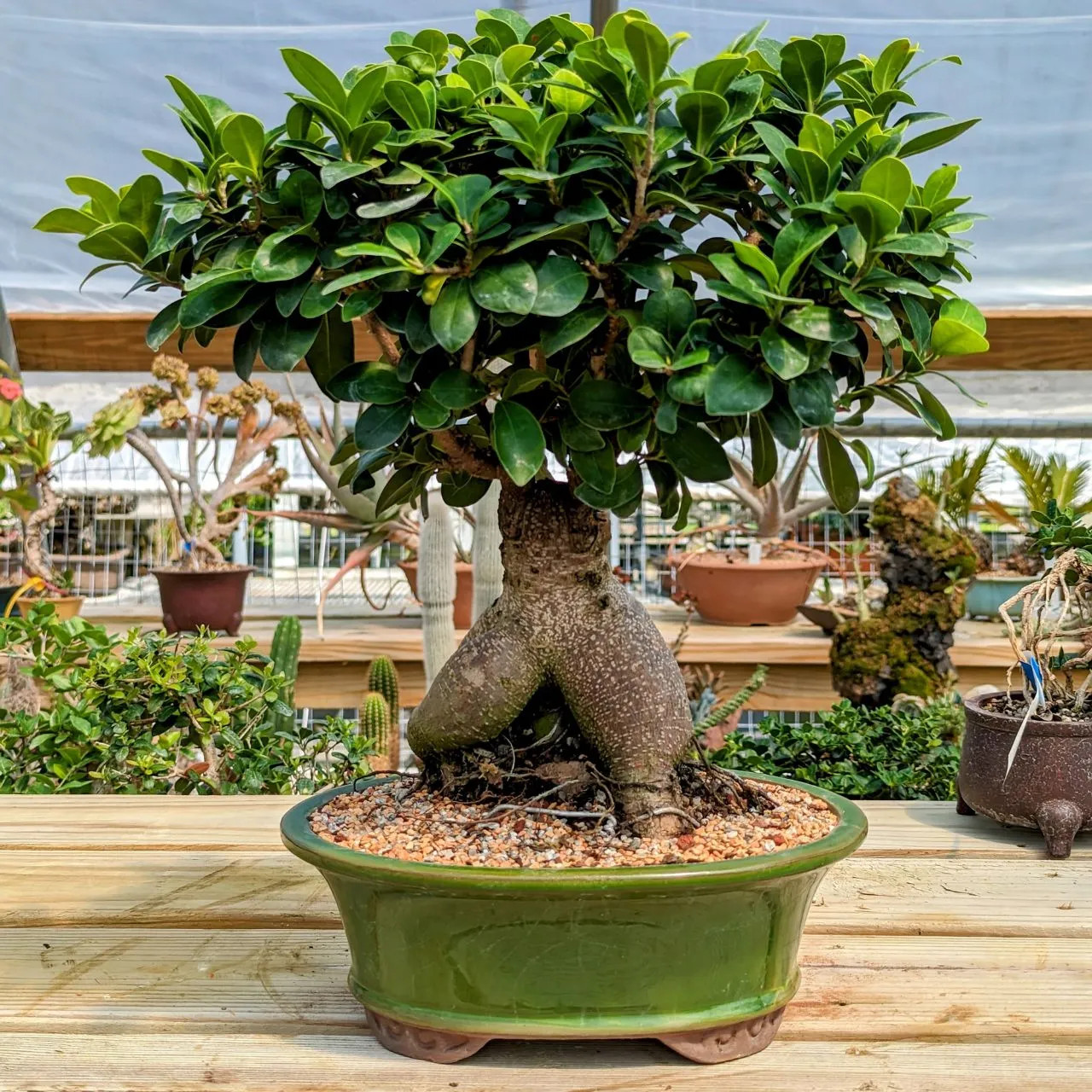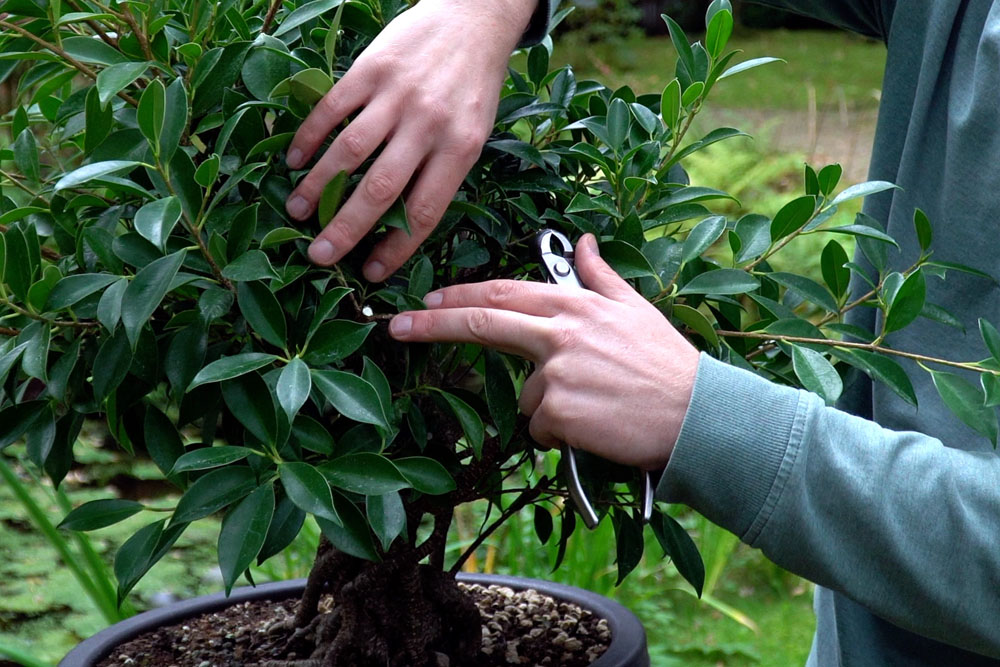Ficus bonsai trees are popular among bonsai enthusiasts due to their resilience, adaptability, and aesthetic appeal. These miniature trees, which belong to the fig family, can be grown indoors, making them perfect for home decor. Ficus bonsai are easy to care for, even for beginners, and they come in a variety of species, each with unique characteristics.
Choosing the Right Ficus Species

When selecting a Ficus species for bonsai, it’s essential to choose one that suits your experience level, aesthetic preferences, and the growing conditions available. Three of the most popular species for bonsai cultivation include Ficus Retusa, Ficus Benjamina, and Ficus Microcarpa. Each of these species offers unique characteristics that make them well-suited for bonsai, making them favorites among bonsai enthusiasts.
Ficus Retusa is particularly well-known for its robust, thick trunk and its ability to develop impressive aerial roots, which can add a striking visual element to your bonsai. These roots can be trained to grow down into the soil, creating a dramatic effect that emphasizes the tree’s age and stability. The thick, gnarled trunk of Ficus Retusa gives it a mature, weathered appearance, making it an excellent choice for creating a bonsai that looks like an ancient, miniature tree. This species is also highly adaptable, making it suitable for beginners and experienced growers alike.
Ficus Benjamina, often referred to as the Weeping Fig, is prized for its elegant, slender branches that cascade gently downward, creating a graceful, weeping silhouette. The small, glossy leaves of Ficus Benjamina are dense and abundant, providing a lush, verdant canopy that is both attractive and easy to maintain. This species is particularly responsive to shaping and pruning, allowing you to create intricate, delicate designs with ease. Ficus Benjamina is also known for its adaptability to indoor environments, making it a popular choice for those who wish to cultivate bonsai indoors.
Ficus Microcarpa, also known as the Chinese Banyan, is another excellent choice for bonsai due to its small leaves, smooth bark, and propensity for developing aerial roots. This species is highly versatile and can be styled in various ways, from formal upright to informal styles, making it a favorite among bonsai artists who enjoy experimenting with different shapes and forms. Ficus Microcarpa is also very resilient, tolerating a wide range of conditions, which makes it ideal for beginners or those who may not have perfect growing conditions. Its ability to quickly adapt and thrive in different environments ensures that your bonsai will remain healthy and vigorous with the proper care.
When choosing the right Ficus species for your bonsai, consider your local climate, the amount of natural light available, and your experience level. Each of these species has its unique attributes and care requirements, so selecting the one that aligns best with your needs will set you on the path to creating a beautiful and healthy Ficus bonsai.
Planting and Potting Your Ficus Bonsai
Planting and potting your Ficus bonsai correctly is crucial for establishing a strong foundation for your tree’s health and growth. Begin by selecting a shallow bonsai pot that provides good drainage, as Ficus trees prefer soil that drains well but retains some moisture. The pot should have drainage holes to allow excess water to escape, preventing root rot. The size of the pot should be proportional to the size of your bonsai, allowing enough room for root development while still maintaining the aesthetic balance of the tree and pot.
Next, prepare a well-draining soil mix suitable for Ficus bonsai. A typical bonsai soil mix might include akadama (a type of clay), pumice, and lava rock in equal parts. Akadama helps retain moisture and provides nutrients, pumice improves aeration, and lava rock aids in drainage. This combination ensures that the roots receive adequate oxygen while preventing water from stagnating in the pot.
When planting your Ficus bonsai, carefully remove the tree from its nursery pot, taking care not to damage the roots. Gently tease out any circling roots, and trim any excessively long or damaged roots with clean, sharp scissors. Place a layer of the prepared soil mix at the bottom of the bonsai pot, and then position the tree in the pot, ensuring it is slightly off-center to create a more natural look. The roots should be spread out evenly over the soil. If necessary, secure the tree in place using bonsai wire, which can be anchored through the drainage holes of the pot. This will help stabilize the tree while it establishes itself in its new environment.
Once the tree is securely positioned, add more soil around the roots, pressing it down gently to eliminate air pockets. Ensure that the tree is firmly planted but not overly compacted, as the roots need room to grow and access to oxygen. After planting, water the bonsai thoroughly to help settle the soil and remove any remaining air pockets. The first watering is particularly important, as it ensures the roots are in good contact with the soil, which promotes healthy growth.
Watering and Fertilizing Your Ficus Bonsai
Watering your Ficus bonsai correctly is essential to its health and vitality. Ficus trees prefer consistently moist soil, but they do not tolerate waterlogged conditions. The key is to maintain a balance where the soil is kept slightly moist but not soggy. During the growing season, typically from spring to autumn, your bonsai will need more frequent watering, especially during hot, dry periods. Check the moisture level of the soil regularly by inserting your finger about an inch into the soil. If it feels dry at that depth, it’s time to water.
When watering, it’s important to water deeply to ensure that the entire root system receives moisture. Water the bonsai until water drains out of the bottom of the pot, indicating that the soil is thoroughly saturated. Be sure to empty the drainage tray if you are using one, as standing water can lead to root rot. During the winter months, when the tree’s growth slows down and it enters a semi-dormant state, reduce the watering frequency accordingly. The soil should still be kept slightly moist, but you can allow it to dry out a bit more between waterings compared to the growing season.
In addition to proper watering, regular fertilization is essential to provide your Ficus bonsai with the nutrients it needs for healthy growth. Use a balanced liquid bonsai fertilizer every two weeks during the growing season to support the development of leaves, branches, and roots. A balanced fertilizer typically contains equal parts of nitrogen (N), phosphorus (P), and potassium (K), which promote overall health and vigor. Nitrogen encourages lush foliage, phosphorus supports strong root development, and potassium enhances the tree’s overall resilience and stress tolerance.
As the growing season ends and the tree enters dormancy, reduce or stop fertilizing altogether. Over-fertilizing during this period can lead to nutrient imbalances and stress the tree. By adjusting your watering and fertilizing routine according to the seasons, you can ensure that your Ficus bonsai remains healthy and vibrant throughout the year.

Pruning and Shaping Your Ficus Bonsai
Pruning is a crucial aspect of maintaining the health, shape, and size of your Ficus bonsai. Regular pruning helps to control the tree’s growth, encouraging a compact form and promoting the development of dense foliage. Pruning should be done thoughtfully and with care to ensure that the tree remains balanced and aesthetically pleasing.
When pruning, focus on removing unwanted growth, such as overly long branches, shoots that disrupt the tree’s shape, and any dead or damaged branches. Pruning back new growth is especially important because it encourages branching, which is key to developing a full, bushy canopy. As you prune, aim to maintain the tree’s overall design, whether you’re working towards a formal upright style, a cascading style, or something more informal.
Using the right tools is essential for effective pruning. Always use sharp, clean bonsai shears or scissors to make precise cuts, minimizing the risk of damaging the tree. Dull tools can crush or tear the branches, leading to uneven cuts that may not heal properly. Clean your tools before and after each use to prevent the spread of disease and infection.
In addition to regular pruning, you can use wiring techniques to shape the branches and guide the growth of your Ficus bonsai. Wiring involves wrapping soft aluminum or copper wire around the branches and gently bending them into the desired position. This technique is particularly useful for shaping young, flexible branches, but it can also be applied to older branches with care. When wiring, be cautious not to over-tighten the wire, as Ficus branches are relatively soft and can be easily damaged. Check the wires regularly and remove them once the branches have set in their new position, usually within a few months. If left on too long, the wire can cut into the bark and cause unsightly scars.
Remember, shaping your Ficus bonsai is an ongoing process that requires patience and regular attention. By combining careful pruning with strategic wiring, you can create a beautifully shaped tree that reflects your vision and enhances the natural beauty of the Ficus species.
Common Pests and Problems
Ficus bonsai are generally hardy, but they can still be susceptible to pests such as aphids, spider mites, and scale insects. Regularly inspect your tree for any signs of infestation. If pests are detected, treat the tree with insecticidal soap or neem oil. Additionally, root rot can be an issue if the bonsai is overwatered, so ensure proper drainage and avoid letting the soil stay too wet.
Caring for a Ficus bonsai is a rewarding experience that allows you to connect with nature on a miniature scale. With proper care, including choosing the right species, planting correctly, and maintaining regular pruning and watering, your Ficus bonsai can thrive and bring a touch of natural beauty to your home.
